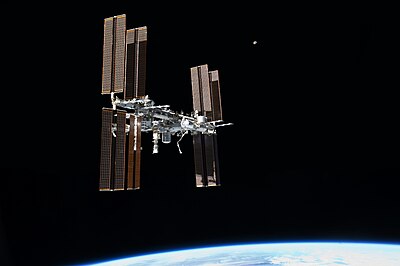Space station
From Wikipedia, the free encyclopedia
A space station, also known as an orbital station or an orbital space station, is a spacecraft capable of supporting a crew, which is designed to remain in space (most commonly as an artificial satellite in low Earth orbit) for an extended period of time and for other spacecraft to dock. A space station is distinguished from other spacecraft used for human spaceflight by lack of majorpropulsion or landing systems. Instead, other vehicles transport people and cargo to and from the station. As of September 2014 two space stations are in orbit: the International Space Station, which is permanently manned, and China's Tiangong-1 (which successfully launched on September 29, 2011), which is unmanned most of the time.[1][2] Previous stations include the Almaz andSalyut series, Skylab and most recently Mir.
Today's space stations are research platforms, used to study the effects of long-term space flight on the human body as well as to provide platforms for greater number and length of scientific studies than available on other space vehicles. All space stations to date have been designed with the intention of rotating multiple crews, with each crew member staying aboard the station for weeks or months, but rarely more than a year. Since the ill-fated flight of Soyuz 11 to Salyut 1, all manned spaceflight duration records have been set aboard space stations. The duration record for a single spaceflight is 437.7 days, set by Valeriy Polyakov aboard Mir from 1994 to 1995. As of 2013, three astronauts have completed single missions of over a year, all aboard Mir.
Space stations have also been used for both military and civilian purposes. The last military-use space station was Salyut 5, which was used by the Almaz program of the Soviet Union in 1976 and 1977.[3]


